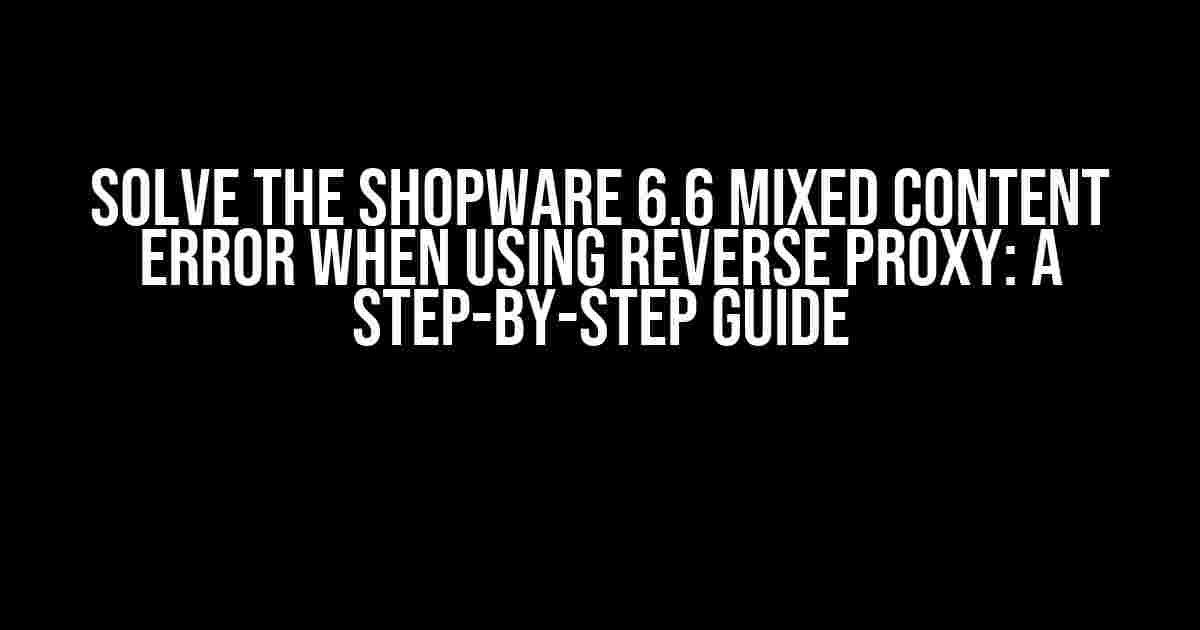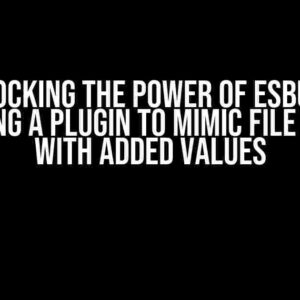Are you tired of encountering the notorious mixed content error in Shopware 6.6 when using a reverse proxy? You’re not alone! This frustrating issue can bring your ecommerce site to a grinding halt, causing anxiety and lost sales. Fear not, dear developer, for today we’ll dive into the depths of this problem and emerge victorious with a clear understanding of the solution.
What is a Mixed Content Error?
A mixed content error occurs when a secure webpage (HTTPS) loads content from an insecure source (HTTP). This mismatch in security protocols triggers a warning in the user’s browser, alerting them to the potential security risk. In the case of Shopware 6.6, this error can manifest when using a reverse proxy, which we’ll explore in more detail below.
Understanding Reverse Proxy and Shopware 6.6
A reverse proxy is a server that acts as an intermediary between a client (browser) and a server (Shopware 6.6). It allows you to forward incoming requests from the client to the server, while also providing an additional layer of security, caching, and load balancing. In the context of Shopware 6.6, a reverse proxy can be used to:
- Improve performance by offloading SSL/TLS encryption
- Enhance security by hiding internal IP addresses
- Simplify URL structures and routing
However, when using a reverse proxy with Shopware 6.6, the mixed content error can arise due to the conflicting security protocols.
Causes of the Mixed Content Error in Shopware 6.6 with Reverse Proxy
The mixed content error in Shopware 6.6 with a reverse proxy can occur due to several reasons:
- HTTP Resources in Shopware 6.6 Templates: If your Shopware 6.6 templates contain hardcoded HTTP URLs, they will trigger the mixed content error when loaded over HTTPS.
- Incorrect Reverse Proxy Configuration: Misconfigured reverse proxy settings can cause the proxied requests to be sent over HTTP instead of HTTPS, resulting in the error.
- Outdated or Misconfigured SSL Certificates: Expired, invalid, or misconfigured SSL certificates can prevent the reverse proxy from establishing a secure connection, leading to the mixed content error.
Solution: Step-by-Step Instructions to Resolve the Mixed Content Error
Fear not, dear developer! With these step-by-step instructions, you’ll be able to resolve the mixed content error in Shopware 6.6 with a reverse proxy:
Step 1: Update Shopware 6.6 Templates to Use HTTPS
Review your Shopware 6.6 templates and update any hardcoded HTTP URLs to use HTTPS instead. You can use the `{% url %}` function to generate protocol-relative URLs:
<{% url 'https' %}>https://example.com</{% url %}>This will ensure that all internal links and resources are loaded over HTTPS.
Step 2: Configure Reverse Proxy Settings
Verify that your reverse proxy settings are correctly configured to forward requests over HTTPS:
server {
listen 443 ssl;
server_name example.com;
location / {
proxy_pass http://localhost:8080;
proxy_http_version 1.1;
proxy_set_header Upgrade $http_upgrade;
proxy_set_header Connection 'upgrade';
proxy_set_header Host $host;
proxy_cache_bypass $http_upgrade;
}
ssl_certificate /path/to/ssl/certificate.crt;
ssl_certificate_key /path/to/ssl/certificate.key;
}In this example, we’re configuring NGINX as the reverse proxy server, but the principles apply to other reverse proxy software as well.
Step 3: Verify and Update SSL Certificates
Ensure that your SSL certificates are up to date and correctly configured:
- Verify the expiration date and validity of your SSL certificates.
- Update any expired or invalid certificates.
- Configure your reverse proxy server to use the updated SSL certificates.
Step 4: Test and Verify the Solution
Reload your Shopware 6.6 site and verify that the mixed content error has been resolved:
- Use a tool like Why No Padlock?to scan your site for mixed content errors.
- Verify that all internal links and resources are loaded over HTTPS.
- Test your site on different browsers and devices to ensure compatibility.
Conclusion
The mixed content error in Shopware 6.6 with a reverse proxy can be a frustrating and complex issue to resolve. However, by following these step-by-step instructions, you’ll be able to identify and fix the root causes of the error, ensuring a seamless and secure shopping experience for your customers. Remember to regularly review and update your Shopware 6.6 templates, reverse proxy settings, and SSL certificates to maintain optimal performance and security.
| Keyword | crawl frequency | crawl priority |
|---|---|---|
| Shopware 6.6 Mixed Content Error | Daily | High |
| Reverse Proxy Configuration | Weekly | Medium |
| SSL Certificate Management | Monthly | Low |
By following this comprehensive guide, you’ll be well on your way to resolving the mixed content error in Shopware 6.6 with a reverse proxy, ensuring a secure and optimal ecommerce experience for your customers.
Here are 5 Questions and Answers about “Shopware 6.6 mixed content error when using reverse proxy”:
Frequently Asked Question
Get the lowdown on solving those pesky mixed content errors when using a reverse proxy with Shopware 6.6!
What is the mixed content error in Shopware 6.6, and why does it happen when using a reverse proxy?
The mixed content error occurs when your Shopware 6.6 store is loading both HTTP and HTTPS content, causing browser warnings and potential security risks. This happens when using a reverse proxy because the proxy can sometimes force the store to load content over HTTP, even if your site is configured to use HTTPS.
How can I identify if my Shopware 6.6 store is experiencing a mixed content error?
Check your browser’s console or developer tools for warnings or errors related to mixed content. You can also use online tools like WhyNoHTTPS or SSL Check to scan your site for mixed content issues.
What are some common causes of mixed content errors in Shopware 6.6 when using a reverse proxy?
Common causes include misconfigured proxy settings, incorrect SSL certificates, or plugin/theme assets being loaded over HTTP. Additionally, hardcoded HTTP URLs in your theme or custom code can also trigger mixed content errors.
How can I fix mixed content errors in Shopware 6.6 when using a reverse proxy?
To fix mixed content errors, ensure your reverse proxy is configured to use HTTPS, update your SSL certificates, and check for hardcoded HTTP URLs in your theme or custom code. You can also use plugins like the Shopware HTTPS Enforcer to force HTTPS loading of all assets.
What are the consequences of not fixing mixed content errors in Shopware 6.6 when using a reverse proxy?
Ignoring mixed content errors can lead to browser warnings, SEO penalties, and a loss of customer trust. It can also compromise your store’s security and make it vulnerable to attacks. Fixing mixed content errors is crucial for maintaining a secure and trusted online shopping experience!



